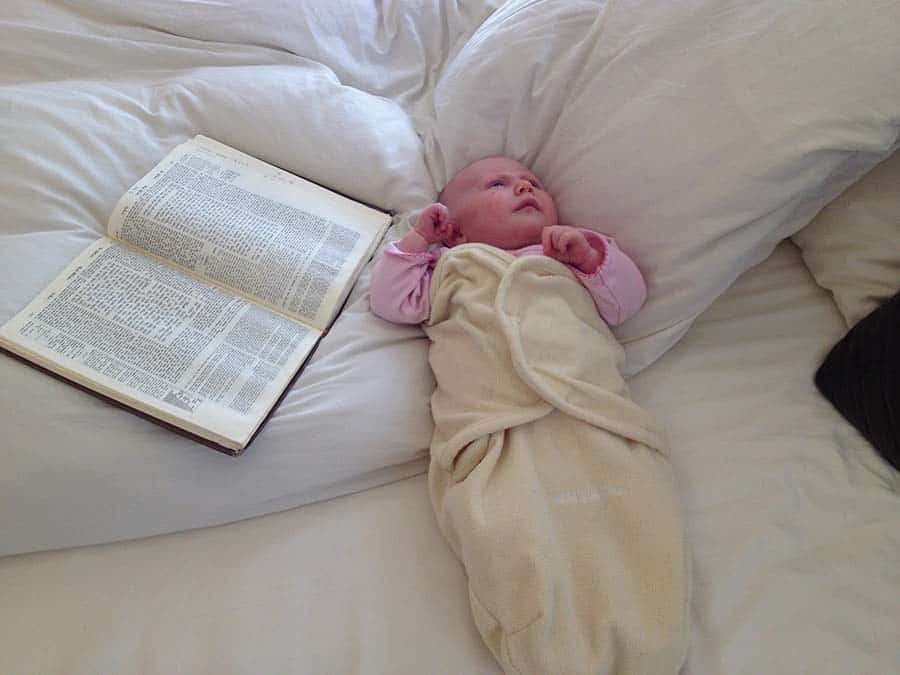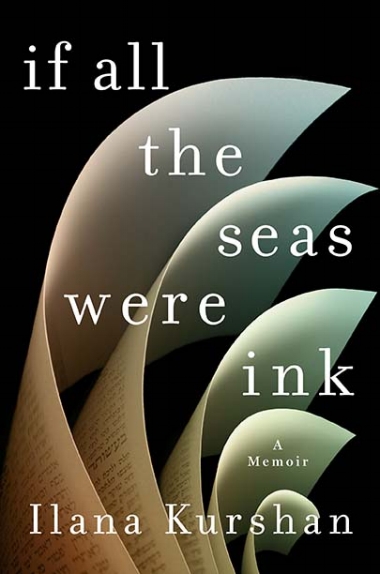Jeffrey L. Rubenstein
I have always been a daf yomi skeptic. Although I am a Talmudist and spend hours each day on Talmud scholarship, I find the rate of a “page a day” far too fast to achieve any substantive understanding. The relentless pace forces the reader to move on before mastering any given passage. When one has to cover two or more pages to make up for the inevitable missed day or days, comprehension becomes increasingly futile. Complex and difficult Talmudic reasoning is translated by virtually all daf yomi instructors, but not adequately explained, as most sessions are compacted to 45 minutes or so. This is not to minimize the salutary ritual aspects of daf yomi such as connecting the Jewish world in a shared endeavor, cultivating a commitment to Jewish tradition, and engaging in the mitzvah of Torah study for its own sake; I just don’t think one retains much Talmud content.
Ilana Kurshan’s delightful new book, If All the Seas Were Ink has now proven me wrong. This memoir recounts 7 ½ years of Kurshan’s life from 2004 to 2011, ages 27-35, as she studied daf yomi in Jerusalem. Kurshan tells of her failed first marriage and divorce; of the ensuing depression, self-doubt, loss of confidence, and despair; of her efforts to pick up the pieces of her life and to begin dating again; and of fresh love, remarriage, and birth of three children. The course of daily Talmud study structures the book, as Kurshan integrates this personal narrative with the traditions she encounters on the Talmud’s thousands of pages. The book is thus a “bibliomemoir,” a term coined by Joyce Carol Oates for a genre of literature combining engagement with a specific book or corpus of books with autobiography, or more exactly a “talmudomemoir.” The ritual “page a day” forces Kurshan to keep going in tough times, centers her in good times, and informs her religious and emotional struggle to lead a life of piety and study.
The titles of the book’s chapters correspond to the tractates of the Talmud she studied over the seven-year cycle: Yoma (Day of Atonement), Sukkah, Beitzah (Festival Laws), Rosh Hashanah … Ketubot (Marriage Contracts) … Gittin (Divorces) etc. This structuring device evokes Primo Levi’s The Periodic Table, with its chapters named after the elements and the corresponding autobiographical connections to chemical experiments. Yet the primary template is the great Church Father Augustine’s Confessions, with the story of a lost and fallen protagonist recounted by the saved and redeemed narrator ultimately converging in the redemptive experience. Where Augustine interweaves biblical verses into his account of his professional, emotional, and philosophical-religious quests and applies them to the events of his life, Kurshan carries out a similar project with Talmudic passages. For both, authentic living is realized in study such that texts and books pervade and shape their experience. Yet the solutions to their respective journeys could not be more different: Augustine finds truth and meaning in Paul and Christianity, where Kurshan finds wholeness in love, marriage, and building a Jewish home. Salvation, for Augustine, entails celibacy, poverty, and abandonment of all this worldly pursuits; for Kurshan salvation requires marriage, children, and the mundane routines of raising a family. This contrast encapsulates a core difference between rabbinic Judaism and certain types of Christianity: the rejection of the body and of this world as opposed to the embrace of both.
The most enjoyable feature of the book is the brilliant and creative integration of the daily Talmudic folio Kurshan studies with experiences of her life. Kurshan draws a connection between the Talmudic discussion of the terumat ha-deshen, the first ritual activity each morning in the Temple, where the priests cleared away the previous night’s ashes from the altar, to emptying the dishwasher upon waking up, “a ritual that links the day that has passed to the day that is dawning.” Studying the laws of hezek re’iyah, “the damage of seeing,” which apply to constructing dwellings that look into the domain of a neighbor, Kurshan reflects on the difficulties of growing up as child of a rabbi in a house next to synagogue, constantly on public display. When her daughter’s lost stuffed elephant is replaced by another and then miraculously found, the child experiences confusion as to which is the “real” beloved elephant. Kurshan invokes the Talmudic deliberation over which animal is holy when a lamb designated as the Passover sacrifice is lost, replaced, and then found.
Upon learning she is pregnant with twins, and experiencing apprehension at the possible complications, she discusses the Talmud’s anxiety over “pairs,” apparently a curious relic of Mesopotamian superstition about even numbered sets of objects. Interrogated by an overly aggressive airlines agent about her motives for returning to Israel and plans in the holy land, she opines that his relentless questioning violates the Talmud’s warning against delving into “what is in front of you and what is behind you,” in traditional context referring to the times prior to creation and of the messiah. Every occasion, from the most mundane to the most extraordinary, recalls a Talmudic tradition. I have always considered assertions that the Talmud is an encyclopedic work covering every facet of human life, or that the Talmud’s “contours are a reflection of life itself” to be exaggerated. But Kurshan’s book goes a long way to making that case.
These innovative applications of particular Talmudic passages are accompanied by hundreds of discussions of general traditions about marriage, divorce, childbirth, the Sabbath, holidays, prayer, and other elements of Jewish life and history. Kurshan confesses that, having flirted with vegetarianism for years, she became a full-fledged vegetarian after studying the Talmudic tractates that detail the laws of slaughtering animals and decapitating birds for sacrifices. She recalls studying the laws about how to hang a person while visiting the Tower of London in England, and the laws of questioning witnesses while visiting the Palais de Justice in Paris. In this respect the book is much more than a personal account of one woman’s encounter with the Talmud but serves as a wonderful general introduction to the Talmud and a valuable resource for Jewish literacy and education.
Kurshan is not only a student of Talmud but a student of texts and books in general. She received an undergraduate degree in English literature from Harvard, and worked as a book editor, literary agent, and translator in New York and Jerusalem. Her knowledge of English literature and poetry is remarkable, and she seamlessly weaves quotations from these texts into her book to complement passages from Bible and Talmud. Kurshan quotes not only from such famous authors as Shakespeare, Dickenson, Hawthorne, Blake, Coleridge, Whitman, and Woolf, but from Wallace Stevens, Alexander McCall Smith, Wendy Cope, Colleen McCullough, Jack Gilbert, Kenneth Koch, and dozens of others. (I had never heard of many of the authors she quotes; feeling rather stupid is one downside of reading this book.)
Wrestling with taking the plunge into marriage, Kurshan invokes Eliza Griswold’s poem “Tigers,” which describes two lovers on a precipice with tigers threatening from above and below, and William Blake’s “The Tyger,” explaining that she “chose Griswold’s pluck over Blake’s terror.” When she has last minute jitters her fiancée calms her nerves by quoting an apt passage of Talmud; he then responds to her anxiety expressed through an allusion to a line from William Matthew’s “Misgivings,” by quoting from the continuation of the poem—at this point the reader knows Kurshan has met her true soulmate.
Kurshan reads voraciously and constantly, governed by a horror of bitul zeman, idle time, the rabbinic concept of never wasting time that could be spent productively on study. She reads in elevators, in line at the supermarket and post office, in doctors’ offices, and when walking down the street—to the point where she developed a reputation in Jerusalem “as the woman who reads and walks.” When forced to swim for exercise after a broken foot precludes jogging, she is frustrated at the wasted time in the pool, so she covers poems with plastic wrap and leaves them at the end of the lane to sneak peeks before swimming the next length. “This was how I memorized all of Edwin Arlington Robinson’s ‘Eros Turannos,’” she mentions in passing. Were I not confident of her virtuous character, I would think she means to shame the rest of us slackers.
Apart from the framing narrative arc of divorce and misery to remarriage and bliss, not much happens. The book is about mundane, quotidian life: buying groceries, cooking dinner, feeding infants, watering plants, cleaning the apartment. These ordinary pursuits serve the larger goal of a life dedicated to study and observance. Kurshan fills her days with prayer, organizing worship services, attending lectures, celebrating the festivals, Talmud study, Bible classes, reading, and still more study. She works tirelessly to integrate the holy and the profane, such as preparing Talmud themed dishes, including Resh LaQuiche, named for the Talmudic sage Resh Lakish. Here and there the book addresses larger theological or cultural issues, such as the existence of God, the efficacy of prayer, the Arab-Israeli conflict, and Israel-Diaspora relations. These are dealt with in a perfunctory manner, almost as if fulfilling an obligation—how can a book about seven years in Jerusalem not mention Arabs? Kurshan has few novel insights in any case, though admittedly these are difficult issues.
Perhaps one exception is gender, as the anomaly of a woman attending daf yomi classes provokes questions from the typical audience of religious males, and Kurshan’s involvement in egalitarian minyanim and Torah-reading stands out against the religious landscape of Jerusalem. In some ways, however, the minor importance of these larger questions is precisely the lesson of the book: the observant Jewish life or study takes place very much in the trenches, in the everyday struggles, and does not require answers to larger theological and philosophical problems.
If all the Seas were Ink has a heartwarming tenor. “It did not seem possible that such supreme joy could be my rightful lot” she marvels at her newfound love. Coming from just about anyone else, I would find such sentiment trite. Kurshan’s purity and goodness make it feel innocently honest. For those not enamored by the seven year commitment to daf yomi, Kurshan’s memoir may be the next best thing.











 Site Operations and Technology by The Berman Consulting Group.
Site Operations and Technology by The Berman Consulting Group.